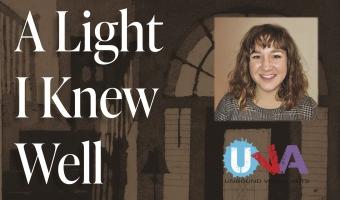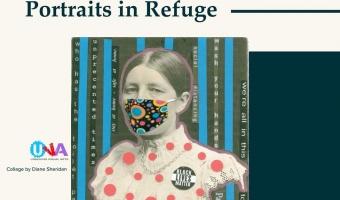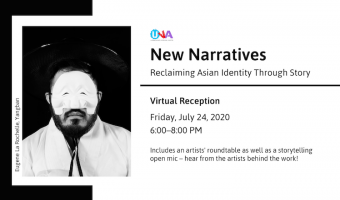Stronger Sisterhood: Representing Intersectional Identity, curated by Paige Moreau
NOTE: The catalogue to the left includes all of the art. To view the all artist statements and biographies visit https://www.unboundvisualarts.org/stronger-sisterhood-catalogue
Stronger Sisterhood:
Representing Intersectional Identity
“As long as women are using class or race power to dominate other women, feminist sisterhood cannot be fully realized” -bell hooks
"Stronger Sisterhood: Representing Intersectional Identity," is a virtual exhibition in a virtual gallery that explores the multidimensional and intersectional identities of women.
The history of feminism has often been described in “waves”. The first wave is defined by the fight for women’s suffrage from the late 19th to early 20th century. The second wave, in the mid 20th century, focused on gender equality in the workplace, the home, and in civil liberties. Both of these movements, while making great strides for women, failed to address deeper compounded layers of oppression and marginalization faced by many women. First and second wave feminism were largely white middle class women’s movements and were often exclusionary of women of color, the LGBTQ+ community, working class women, women with disabilities and so on. The movements kept a narrow scope by focusing on a one dimensional vision of what it means to be a woman assuming common experiences and levels of marginalization based on gender identity. In reality, oppressions experienced by way of gender do not exist in a vacuum but instead intersect with multiple facets of identity.
In 1989, lawyer, civil rights activist, and critical race theorist, Kimberlė Crenshaw coined the term “intersectionality” to describe how gender, race, class, and other individual characteristics intersect and augment oppressions. At present, the recognition of intersectionality’s importance in women’s rights has grown into a third wave of feminism that strives to recognize all the forms of oppression that female identifying people face.
Art created by a diverse range of female identifying artists is a key into visualizing and representing intersectional experiences. “Stronger Sisterhood: Representing Intersectional Identity” showcases that women’s experiences are not one but many, and only through diversity in representation can we begin to grasp a three dimensional view of all women. How do our experiences as women differ due to other facets of our identity? How are we made stronger by recognizing and honoring these differences? How has the recognition of intersectional feminism grown and where is there more work to be done?
The 1st and 2nd Wave: The Fundamentals
The metaphor of the wave when thinking about the history of feminism has its pitfalls. It can be reductive, instigate intergenerational disagreement and even suggest that women's rights fall in and out of fashion. However, as a historical construct, it has shaped the way we think about the timeline of women's rights and had a deep cultural impact that shows through even into contemporary art. This first grouping of artwork taps into ideas that have been stereotypically considered pertinent to first and second wave feminism. While first and second wave feminism are largely considered unique movements at separate moments in history their basic principles of recognizing inequalities between the sexes and fighting for that equality create a link.
The 3rd Wave: A Tide Shift
Where first and second wave feminism can be nudged into neat time frames third wave feminism is harder to pin to a confined set of dates. However, a sizable shift occurred in the early 1990s originating from thinkers, such as Kimberlé Crenshaw and Judith Butler, that redirected focus under the large umbrella of feminism toward women's intersectional identities. Crenshaw described how different forms of oppression intersect and Butler argued that gender and sex exist separate from one another and that gender is not innate but a learned set of performative characteristics. These strides in our understanding of identity changed the "tide" of feminism to be more inclusive and consider how race, gender identity, sexual orientation, disability status and inform oppression and change the fight for equality.
Today: Women in 2020
2020 was a collective year of reckoning politically, socially and economically and women were often disproportionately impacted, losing more jobs than men, facing heightened inequality at home through unpaid care, and making up 77% of the healthcare workforce. Although women have faced the worst of the pandemic, racial injustices, and income inequality and they have manage to affect enormous change in the past year. Tremendous strides have been made by women, especially women of color, in the form of championing the Black Lives Matter movement, registering record numbers of black voters in Georgia, and rising to the Vice Presidency of the United States. Artists turned to their crafts to make sense of the tumultuous year. Here, artists chose to explore what it means to be a woman in a global pandemic, how a woman's right to choose is still being called into question and how tapping into an over-the-top femininity can be both comforting and empowering.
--Paige Moreau, Exhibition Curator
Stronger Sisterhood:
Representing Intersectional Identity
“As long as women are using class or race power to dominate other women, feminist sisterhood cannot be fully realized” -bell hooks
"Stronger Sisterhood: Representing Intersectional Identity," is a virtual exhibition in a virtual gallery that explores the multidimensional and intersectional identities of women.
The history of feminism has often been described in “waves”. The first wave is defined by the fight for women’s suffrage from the late 19th to early 20th century. The second wave, in the mid 20th century, focused on gender equality in the workplace, the home, and in civil liberties. Both of these movements, while making great strides for women, failed to address deeper compounded layers of oppression and marginalization faced by many women. First and second wave feminism were largely white middle class women’s movements and were often exclusionary of women of color, the LGBTQ+ community, working class women, women with disabilities and so on. The movements kept a narrow scope by focusing on a one dimensional vision of what it means to be a woman assuming common experiences and levels of marginalization based on gender identity. In reality, oppressions experienced by way of gender do not exist in a vacuum but instead intersect with multiple facets of identity.
In 1989, lawyer, civil rights activist, and critical race theorist, Kimberlė Crenshaw coined the term “intersectionality” to describe how gender, race, class, and other individual characteristics intersect and augment oppressions. At present, the recognition of intersectionality’s importance in women’s rights has grown into a third wave of feminism that strives to recognize all the forms of oppression that female identifying people face.
Art created by a diverse range of female identifying artists is a key into visualizing and representing intersectional experiences. “Stronger Sisterhood: Representing Intersectional Identity” showcases that women’s experiences are not one but many, and only through diversity in representation can we begin to grasp a three dimensional view of all women. How do our experiences as women differ due to other facets of our identity? How are we made stronger by recognizing and honoring these differences? How has the recognition of intersectional feminism grown and where is there more work to be done?
The 1st and 2nd Wave: The Fundamentals
The metaphor of the wave when thinking about the history of feminism has its pitfalls. It can be reductive, instigate intergenerational disagreement and even suggest that women's rights fall in and out of fashion. However, as a historical construct, it has shaped the way we think about the timeline of women's rights and had a deep cultural impact that shows through even into contemporary art. This first grouping of artwork taps into ideas that have been stereotypically considered pertinent to first and second wave feminism. While first and second wave feminism are largely considered unique movements at separate moments in history their basic principles of recognizing inequalities between the sexes and fighting for that equality create a link.
The 3rd Wave: A Tide Shift
Where first and second wave feminism can be nudged into neat time frames third wave feminism is harder to pin to a confined set of dates. However, a sizable shift occurred in the early 1990s originating from thinkers, such as Kimberlé Crenshaw and Judith Butler, that redirected focus under the large umbrella of feminism toward women's intersectional identities. Crenshaw described how different forms of oppression intersect and Butler argued that gender and sex exist separate from one another and that gender is not innate but a learned set of performative characteristics. These strides in our understanding of identity changed the "tide" of feminism to be more inclusive and consider how race, gender identity, sexual orientation, disability status and inform oppression and change the fight for equality.
Today: Women in 2020
2020 was a collective year of reckoning politically, socially and economically and women were often disproportionately impacted, losing more jobs than men, facing heightened inequality at home through unpaid care, and making up 77% of the healthcare workforce. Although women have faced the worst of the pandemic, racial injustices, and income inequality and they have manage to affect enormous change in the past year. Tremendous strides have been made by women, especially women of color, in the form of championing the Black Lives Matter movement, registering record numbers of black voters in Georgia, and rising to the Vice Presidency of the United States. Artists turned to their crafts to make sense of the tumultuous year. Here, artists chose to explore what it means to be a woman in a global pandemic, how a woman's right to choose is still being called into question and how tapping into an over-the-top femininity can be both comforting and empowering.
--Paige Moreau, Exhibition Curator



